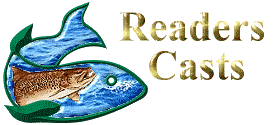IT’S ALL IN THE EYE OF THE HOOK
When it comes to dressing hooks, the tyer looks to see what hook is called for by the fly pattern, manufacturer, model number, and size. Little thought is given to the eye of the hook; is it an up-eye, straight (horizontal or vertical alignment), or a down-eye hook. What difference does it make, which way the eye is, in relation to the hook shank?
Over the years, the hooks become set in their designs by most manufacturers! Most dry fly hooks are light (L) or extra light (XL) using smaller diameter wire for their construction and just about all have down-eyes!
Wet fly and nymph hooks, also have become somewhat uniform in their design with either using a standard (S) diameter (whatever standard means), extra heavy (XH) or extra-extra heavy (2XH); they too have mostly down-eyes!
Now the Streamer Hooks are just extra long Wet Fly Hooks, with lengths of four extra long (4XL) or longer. The streamer hooks are mostly down-eyes, but there are also many that are straight (with some being vertical and some horizontal in their alignment0 with the hooks curved and spear-pointed.
All Salmon Hooks have up-eyes. That is to say that if it is an up eye, and black finish, it is a salmon hook. But you are permitted to use salmon hooks for steelheads. I use salmon hooks for largemouth Bass and Smallmouth bass, because of the up-eye.
So what is so special about the hooks eye, and which way it is position on the hook? Well just about all the action that you want your fly pattern to do; on, in, or beneath the water surface is determined by the position of the eye of the hook. I sometimes believe that fly anglers and dressers of hooks get into a major rut, when going through the same decisions on hook selection, without pausing to think outside the box, and recognize the importance of the hook’s eye and what is does.
Here are the basics of eye positioning:
Up-Eyes: cause the front of the hook to dip down when the tippet is taunt and exerting tension to the fly. Up-eyes give the impression that the fly is swimming for deeper water. That is why almost all salmon hooks have up-eyes.
Down-Eyes: cause the front of the hook to rise toward the surface, giving the impression of a rising nymph, or pupa (caddis) toward the surface. Same for emergers, that with some sort of floatation material just behind the hooks eye, are giving the impression of a nymph or pupa (caddis) attempting to break through the water surface. Almost all dry fly hooks are down-eyes, so that if the fly becomes sunken below the water surface (missed take by a fish or some water eddy), it can be easily returned to the surface, and so it can be dried out with a few false casts before being place again on the water surface.
Straight Eyes: cause the hook shank to wobble either to the right & left, or up & down, in relation to the tippet that it is connected to. You have many knot that can be used: loop knot, buffer loop knot, Rapala knot, nail loop knot, and drop loop knot, just to name a few.
You can turn an Up-Eye or Down-Eye hook fly pattern, into a straight-eye hook pattern by two different means of how you connect the tippet to the hook. You do this by running the tippet through the eye of the hook and doing a “Larks Head Knot”, you have tied just about any loop knot on the end of the tippet, and run the loop knot through the eye, and over the hook shank of the fly, and pulling on the tag end.
“Quick Snell Knot”, where you run the tag end of the tippet through the eye of the hook, wrapping the tippet around the front of the hook four or five times, then running the tag end under the first wrap of the tippet around the front of the hook. Snelling is usually done on a bare hook, with the material for the fly pattern affixed afterwards.
Other Snell Knots include the Uni-Knot Snell, Speed Snell (which can be used to tandem hooks connected to each other), Steelheader’s Egg Loop (used for holding pieces of yarn, foam, plastic material on the hook shank). “Harry’s Loop de Loop” is identical to the Steelheader’s Egg Loop (with two loops for attaching different materials to the hook shank). “Main Line Egg Loop, Salmon Hook Knot,
When fishing I always have “The Little Red Fishing Knot Book” (3½” x 5”, 72 pages) in my fishing vest pocket; 62 knot patterns (with illustrations and instructions on how to tie them). At home the “Little Red Fishing Knot Book” is always available at my fly tying station.
~Parnelli
Credit: “Little Red Fishing Knot Book” (yes it has a red cover), by Harry Nilsson; © 1997. Printed by Hazel Dine Press Ltd., 4610 Marine Dr, Burnaby, BC, Canada, V5J 3G2
